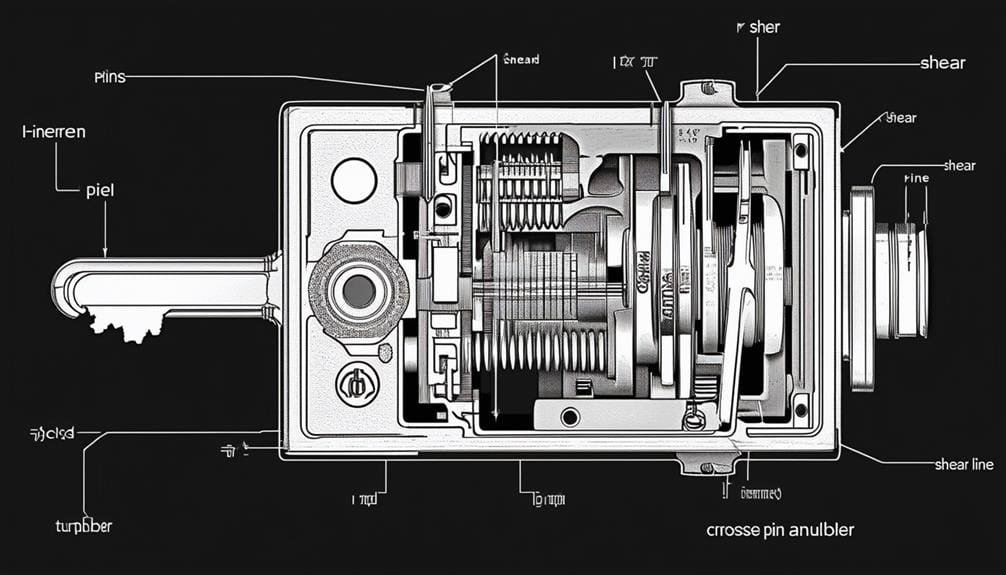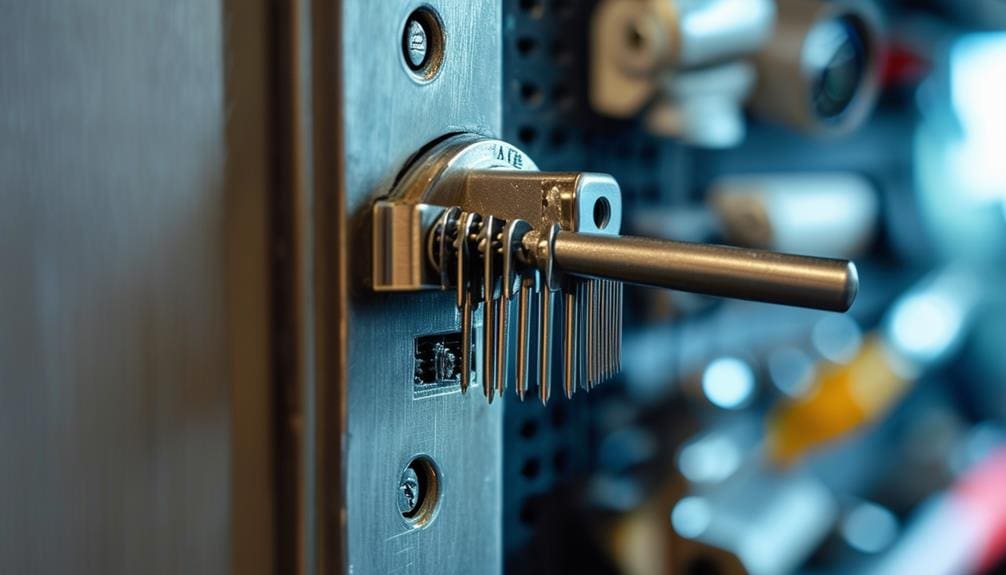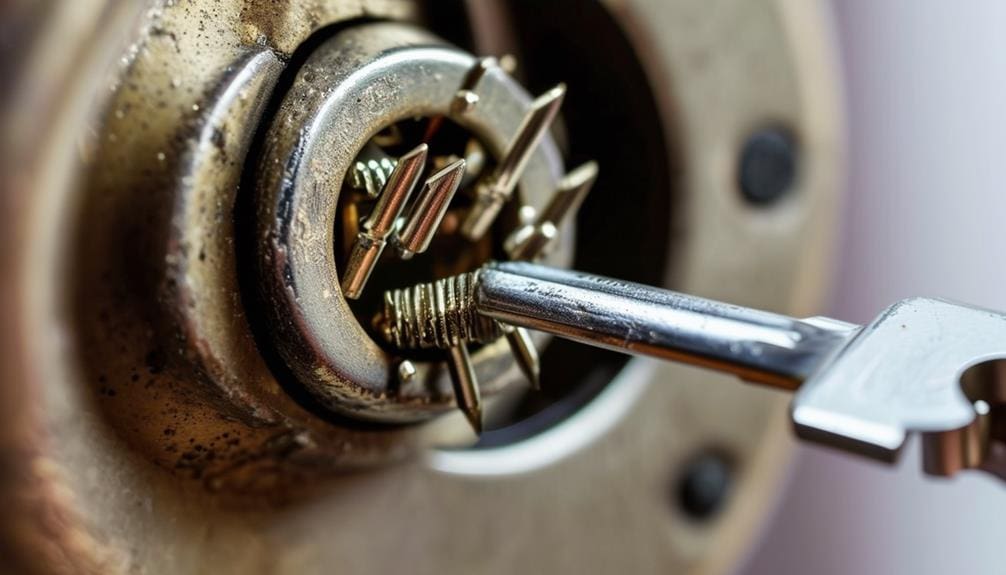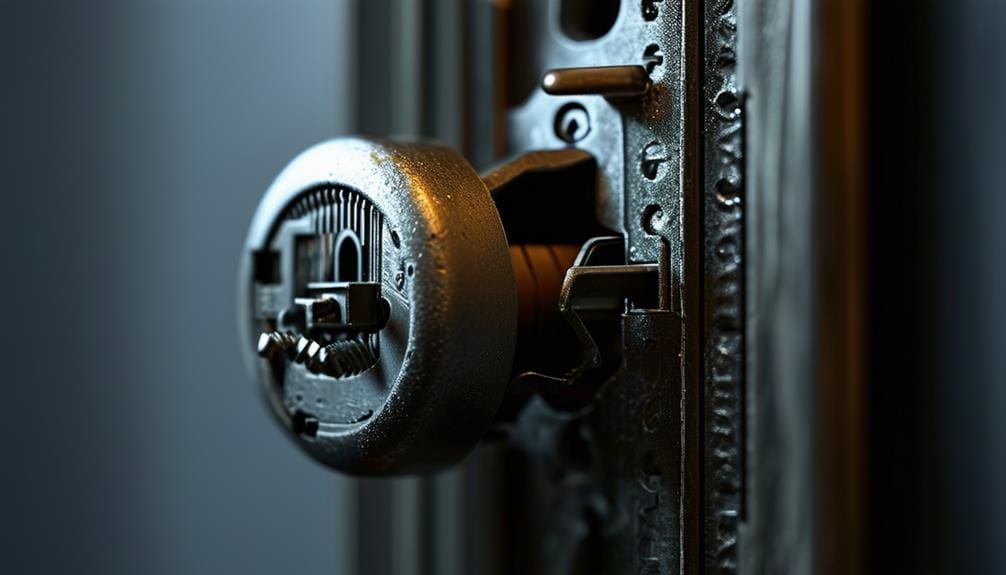You can trust pin tumbler locks for basic security, but it’s important to recognize their potential vulnerabilities. These locks rely on the precise alignment of driver and key pins to create a shear line, enabling the lock to turn. They’re commonly used due to their effectiveness and customization options, like master keying. However, they’re susceptible to lock picking and bumping, where specially cut keys can exploit design flaws. To enhance security, consider upgrading to high-security keyways and adding supplementary measures. Regular professional assessments help maintain their effectiveness. For more detailed information on these topics, further insights await.
Key Takeaways
- Pin tumbler locks offer reliable security through precise alignment of driver and key pins to form a shear line.
- Vulnerabilities exist, such as susceptibility to lock picking and bumping, necessitating regular security assessments.
- High-security keyways and master keying systems enhance the security of pin tumbler locks.
- Professional evaluations and upgrades can identify and mitigate weak points in existing pin tumbler locks.
- Integrating access control systems provides an additional layer of security against unauthorized access threats.
Historical Background
The history of pin tumbler locks dates back to ancient Egypt, where the earliest designs laid the groundwork for the sophisticated mechanisms used today. Around 4000 years ago, Egyptians developed a rudimentary type of lock, consisting of a wooden bolt securing a door, with a set of pins inserted into drilled holes. These pins prevented the bolt from moving unless a specially designed key lifted them to the correct height.
This basic concept evolved over centuries, with notable advancements during the Roman Empire. Romans refined the design by using metal components which increased durability and security. The modern pin tumbler lock, however, took a significant leap forward in the 19th century when Linus Yale Sr. and his son, Linus Yale Jr., introduced the cylinder lock. This type of lock used a combination of driver pins and key biting, allowing for varied security levels and keying options.
Throughout history, pin tumbler locks have remained a popular choice due to their reliability and adaptability. Today, they’re used extensively in residential, commercial, and industrial settings, providing a balance of security and convenience. By understanding the historical evolution of this type of lock, you can appreciate its significance and ongoing relevance in safeguarding properties.
How Pin Tumbler Locks Work

You’ll find that pin tumbler locks depend on a precise interaction between driver pins and key pins. When you insert the correct key, its unique biting pattern lifts the pins to the right height, allowing the lock to turn. This mechanism, along with specific security features, guarantees the lock’s effectiveness and resistance to unauthorized access.
Mechanism and Key Interaction
Imagine inserting a key into a pin tumbler lock and feeling the subtle clicks as the key pins align precisely with the driver pins, allowing the lock to turn and grant access. This interaction is at the heart of the pin tumbler lock’s mechanism. A thorough mechanism analysis reveals that each pin tumbler lock contains a series of driver and key pins. When you insert the correct key, the biting of the key lifts each key pin to the exact height needed to align with the driver pins, creating a shear line that permits the plug to rotate.
Key alignment is essential for the lock’s operation. Each unique key corresponds to a specific combination of pin heights, ensuring that only the correct key can create the necessary alignment. This precise interaction not only makes the lock functional but also forms the basis of its security assessment. By understanding how the key and pins interact, you can evaluate the effectiveness of pin tumbler locks in securing your property.
The design allows for sophisticated systems, such as master keying, where different keys provide various levels of access. This versatility makes pin tumbler locks ideal for a range of applications, from residential to industrial settings.
Security Features Explained
Understanding the security features of pin tumbler locks begins with recognizing how their intricate mechanisms prevent unauthorized access. At the core, these locks operate by aligning driver pins with key pins of varying lengths. When you insert a key, its biting corresponds to the heights of the key pins, lifting them to the shear line. This alignment allows the plug to rotate, opening the lock.
The security layers in pin tumbler locks come from this precise interaction between pins and keys. Each pin acts as a barrier, and only the correct key can align them perfectly. This key control is essential for maintaining security since only keys with the correct biting can open the mechanism.
Lock customization further enhances security by allowing for different configurations. Pin tumbler locks can be master keyed, enabling multiple levels of access within a system. This customization is particularly useful in environments requiring variable access levels, such as residential complexes or commercial buildings.
Common Security Threats

When evaluating the security of pin tumbler locks, you must consider the vulnerabilities from lock picking, the significant risk posed by lock bumping, and various manipulation techniques. These common threats exploit the mechanical weaknesses inherent in traditional pin tumbler designs. Understanding these risks is vital for implementing effective countermeasures and enhancing overall security.
Lock Picking Vulnerabilities
Pin tumbler locks face important security threats from lock picking, where intruders use tools to manipulate the lock’s components and bypass the need for a key. Lock picking techniques exploit the design of these locks by setting the pins at the shear line, allowing unauthorized access without the correct key. This vulnerability is a major concern for both residential and commercial properties due to the relatively low skill required and the accessibility of lock picking tools.
To understand the extent of this threat, consider the following:
- Ease of Learning: Lock picking can be quickly learned through online tutorials, increasing awareness and potential misuse.
- Tool Accessibility: Lock picking tools are readily available, making it easier for individuals to attempt unauthorized access.
- Traditional Design Flaws: Pin tumbler locks have inherent design vulnerabilities, making them susceptible to these techniques.
A thorough vulnerability assessment of your locks is essential. Implementing robust security measures can mitigate these risks. Upgrading to high-security locks with security pins, reinforced materials, or electronic components markedly enhances protection. By addressing these vulnerabilities, you can safeguard your property more effectively against common security threats posed by lock picking.
Risk From Lock Bumping
Beyond lock picking, another important threat to pin tumbler locks is lock bumping, a technique that exploits the design of these locks by using specially cut keys to gain unauthorized access. This method leverages bump keys, which are readily available online, making the risks of lock bumping techniques more common. The ease of acquiring these keys and the minimal skill required to use them notably increase the vulnerability of pin tumbler locks.
Lock bumping dangers are notable because this technique can bypass traditional security measures quickly and efficiently. It involves inserting a bump key into the lock and striking it to manipulate the pins, opening the lock without the original key. This simplicity makes it a favored method among burglars and unauthorized individuals.
To counteract these risks, enhancing your lock system is essential. Upgrading to more secure keyways and using high-security locks can mitigate the threat. Incorporating access control systems adds an additional layer of security, making unauthorized access more challenging. By understanding these lock bumping dangers and prevention methods, you can significantly improve the security of your pin tumbler locks and protect your property effectively.
Manipulation Techniques
Lock manipulation techniques, such as lock picking and lock bumping, represent significant security threats to the integrity of pin tumbler locks. Understanding these methods is pivotal for evaluating the security level of your locks and implementing appropriate countermeasures.
Lock picking involves manipulating the pins inside the lock to simulate the correct key’s action, allowing unauthorized access. This technique exploits vulnerabilities in pin tumbler locks, making it a notable security concern. Lock bumping, on the other hand, uses a specially cut bump key to quickly and easily open pin tumbler locks without leaving visible signs of forced entry. This method is particularly worrisome because it requires minimal skill and leaves little evidence of tampering.
To protect against these threats, consider the following countermeasures:
- Upgrade to high-security keyways: These are designed to resist lock picking and bumping.
- Install additional security measures: Reinforce your lock system with security pins or electronic locks.
- Regularly evaluate your security setup: Stay informed about new manipulation techniques and update your locks accordingly.
Lock Bumping Explained

Many people don’t realize how vulnerable traditional pin tumbler locks are to a technique called lock bumping. This method involves using a specially cut key, known as a bump key, to align the pins inside the lock and turn it. The bump key dangers are important because these keys can be easily purchased online for various lock brands. The lock bumping risks are further heightened by the minimal skill required to execute this technique effectively. With just a few taps, a burglar or intruder can quickly open your door.
The prevalence of online tutorials has made learning lock bumping techniques more accessible, increasing the threat to traditional pin tumbler locks. This ease of access makes it a popular choice among those looking to bypass security measures quickly. However, there are prevention techniques that can mitigate these risks. Upgrading to higher security keyways, implementing access control systems, and securing master keys with digital solutions are effective methods to enhance your lock’s resistance to bumping.
Understanding the mechanics and risks of lock bumping is essential. By being aware of these vulnerabilities and taking appropriate preventive measures, you can greatly improve the security of your property.
Enhancing Pin Tumbler Security

Knowing the vulnerabilities of traditional pin tumbler locks, you can take several practical steps to enhance their security. By focusing on keyway selection, access control, and interchangeable cores, you can greatly boost your lock’s resistance to unauthorized entry attempts.
- Keyway Selection and Security: Re-key your locks to more secure keyways. High-security keyways are designed to resist lock bumping and unauthorized key duplication. They offer an added layer of protection by making sure that only specially cut keys can operate the lock, making it more challenging for intruders to gain access.
- Access Control and Monitoring: Incorporate access control systems with door monitoring. These systems allow you to track who is entering and exiting, and to promptly detect tampering or forced entry attempts. By integrating these technologies, you not only enhance security but also gain valuable insights into access patterns.
- Interchangeable Cores and Compatibility: Utilize interchangeable cores that are compatible with higher security keyways. Interchangeable cores enable quick re-keying without changing the entire lock mechanism, allowing for flexible upgrades and maintenance. This method ensures that your security measures can evolve to address new threats.
Professional Assessment and Upgrades

Engaging a professional locksmith to evaluate your current pin tumbler locks can reveal vulnerabilities and provide tailored upgrade recommendations to enhance security. A thorough vulnerability assessment will identify weak points in your existing locks, highlighting areas where security measures can be enhanced. This methodical approach guarantees that you address specific issues rather than implementing generic solutions.
Upgrading to high-security keyways like Medeco or Mul-T-Lock can greatly increase resistance to lock bumping and picking. These advanced locks are designed with pick-resistant cylinders and anti-bump features, making unauthorized entry much more difficult. Additionally, implementing restricted key systems enhances key control, limiting unauthorized duplication and making sure that only authorized personnel can obtain copies of your keys.
Regular maintenance and inspection by professionals are essential for the continued effectiveness of your upgraded security measures. A locksmith can guarantee that all components function correctly and make necessary adjustments to maintain the highest level of protection.
Frequently Asked Questions
What Is the Advantage of a Pin Tumbler Lock?
You’ll find the advantage of pin tumbler locks in their resistance to lock picking techniques and security vulnerabilities. Locksmith recommendations often highlight their key control, making them ideal for preventing unauthorized access and ensuring thorough security.
What Is the Difference Between a Pin-Tumbler and a Wafer Lock?
Imagine two worlds: pin-tumbler locks use key pins and driver pins, offering solid security features and picking resistance. Wafer locks, with simpler mechanism design, rely on flat wafers. Both differ in key operation and overall security.
What Is a Tumbler in a Safe?
In a safe, a tumbler refers to components within the lock cylinder. The tumbler mechanism, involving driver and key pins, is essential to safe construction and lock security. Proper alignment guarantees only the correct key grants access.
What Are the Components of a Pin Tumbler Lock?
In a pin tumbler lock, you’ve got key pins and driver pins that align at the shear line. Lock picking techniques target these components. Key pin variations and cylinder design considerations guarantee security by making unauthorized access difficult.
Conclusion
You’ve explored the history, mechanics, and vulnerabilities of pin tumbler locks. You’ve understood the threats, grasped the concept of lock bumping, and learned ways to enhance security. Now, it’s essential to take action: assess your current locks, consult with security professionals, and invest in upgraded solutions. By staying informed, staying proactive, and staying vigilant, you can greatly improve your home’s security and peace of mind. Your safety depends on it.
